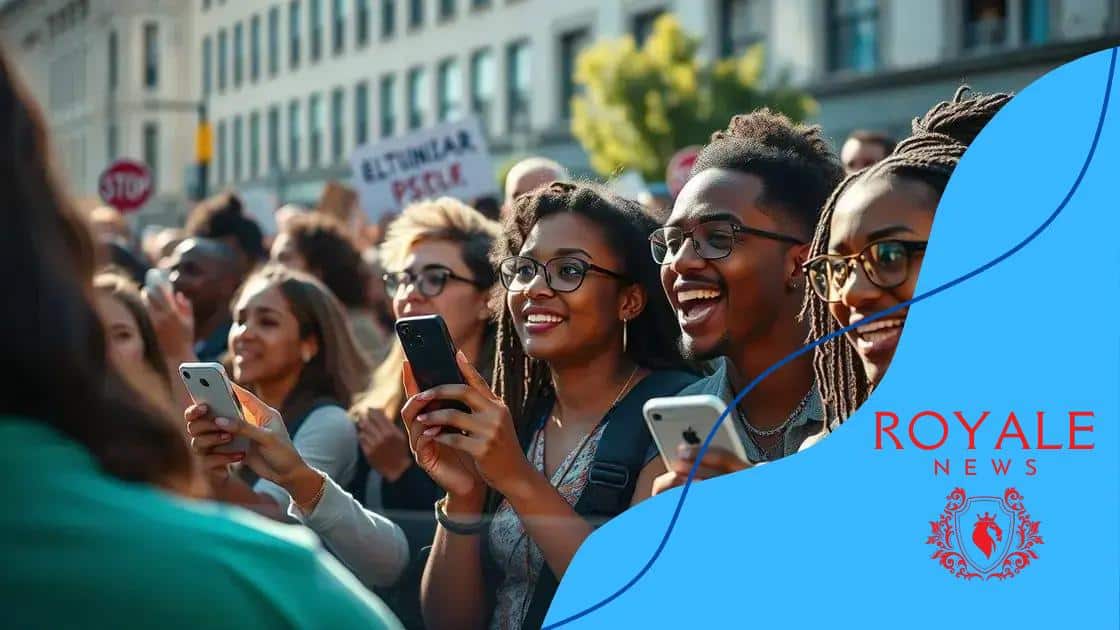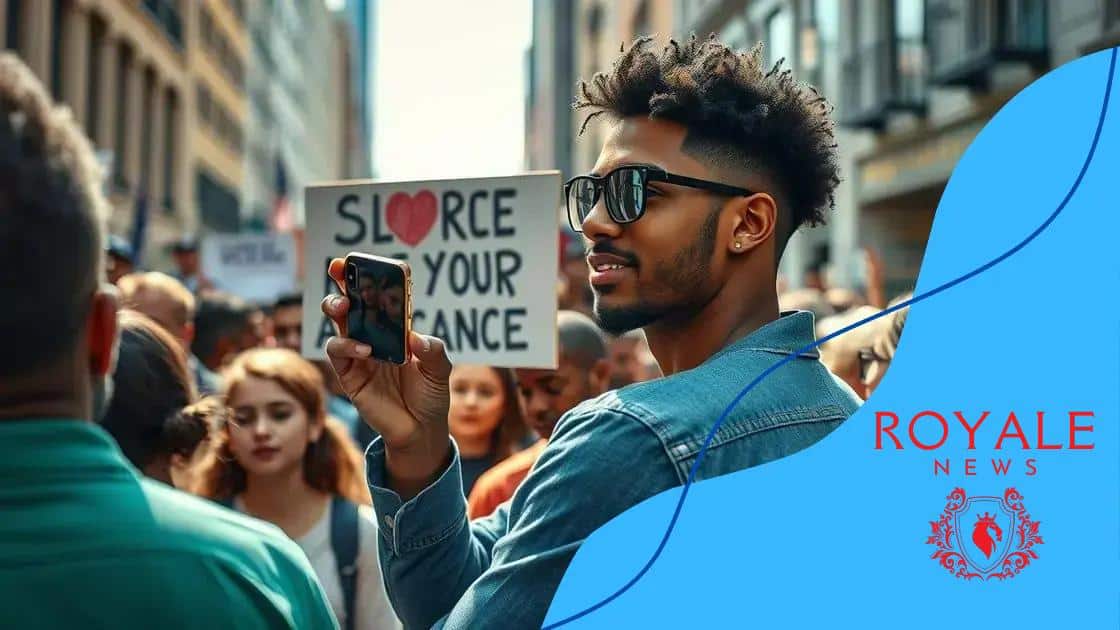Social media’s influence on global movements

Social media’s influence on global movements allows activists to mobilize quickly, amplify their messages, and engage supporters effectively, while also facing challenges like misinformation that can undermine their efforts.
Social media’s influence on global movements is undeniable, shaping how people rally for change. Have you noticed how a hashtag can light a fire under a cause? In this article, we’ll explore its profound impact on activism and society.
The role of social media in mobilizing protests
The rise of social media has transformed how protests are organized and mobilized around the globe. Platforms like Twitter, Facebook, and Instagram enable activists to connect with others instantly, amplifying their voices. The capacity for information spread is unprecedented, allowing for real-time updates and coordination.
How Social Media Mobilizes Protests
Social media’s role in mobilizing protests is significant. The platforms facilitate rapid communication and planning. Activists can share locations, plan events, and communicate with followers. This leads to larger gatherings and a stronger collective voice.
Key Factors in Mobilization
- Instantaneous communication with supporters
- Sharing multimedia content to draw attention
- Creating hashtags that unify messages
- Reaching global audiences to inspire worldwide support
Moreover, social media empowers individuals who might not have traditional platforms. Everyone has a voice, and this democratization of information helps to spotlight grassroots movements. The viral nature of posts can attract national and international media coverage, drawing even more attention.
The importance of visuals cannot be overstated. Striking images or videos can have a powerful impact, drawing in others to support the cause. When users share their experiences, they contribute to a rich tapestry of diverse perspectives, all connected through social media.
In times of crisis, social media becomes a lifeline. It connects people quickly during emergencies and can provide critical information about safety and resources. This immediacy can be crucial during large-scale protests, where conditions can change rapidly.
Understanding the impact of social media allows us to see how it not only mobilizes but also informs and engages communities. Its influence can lead to real change, showing the power of collective action in the digital age.
Case studies of successful movements
Throughout history, various movements have effectively utilized social media to spread their messages and achieve their goals. These case studies showcase the power of online platforms to galvanize support and spark change.
The Arab Spring
The Arab Spring is a notable example of social media’s impact. Activists used platforms like Facebook and Twitter to organize protests and share information. This grassroots movement showcased how digital communication could unite people against oppressive regimes.
Black Lives Matter
The Black Lives Matter movement gained momentum through social media. Hashtags such as #BlackLivesMatter became rallying cries for demonstrations. The movement effectively spread awareness about police brutality and racial inequality, inspiring global protests. Many saw these online efforts translating into real-world actions.
Sunflower Movement
The Sunflower Movement in Taiwan also highlights social media’s role in activism. Using mostly Facebook, young activists organized sit-ins to protest against a trade agreement with China. The movement effectively raised awareness and mobilized thousands to take to the streets, reflecting the power of digital organizing.
Key Elements of Success
- Effective use of hashtags to unify messages
- Strong visuals that capture attention
- Real-time updates to coordinate actions
- Engagement with followers to foster community
Additionally, these movements demonstrate that social media can help maintain momentum. By sharing stories, images, and updates, activists keep their causes in the public eye. This constant presence is vital for sustained engagement, leading to long-term change.
Through these case studies, it is clear that social media not only amplifies voices but also creates a sense of community. Activists around the world can unite, drawing inspiration from one another and sharing strategies to overcome challenges. The interconnectedness provided by social media has made global activism more achievable than ever.
The impact of influencers on activism

Influencers play a significant role in shaping perceptions and driving engagement in the world of activism. With access to millions of followers, they can amplify voices and causes in ways that traditional media cannot. By using social media platforms, influencers raise awareness for social issues effectively.
The Power of Influence
One of the key aspects of an influencer’s impact on activism is their ability to reach broad audiences. When an influencer shares a cause, it often resonates with their followers, motivating them to take action. Many influencers curate meaningful content that engages their audience and encourages discussions on important topics.
Methods Used by Influencers
- Sharing personal stories to connect emotionally
- Using impactful visuals to draw attention
- Partnering with organizations to promote causes
- Hosting live discussions to engage followers directly
These methods bridge the gap between influencers and their followers, creating a powerful network of support. Activism becomes more accessible when influencers utilize their platforms to educate and inform their audiences about urgent issues.
Furthermore, influencers often collaborate with grassroots movements to maximize their impact. This collaboration increases visibility for causes, making them more relatable to everyday people. Social media allows these partnerships to flourish, breaking down barriers between influencers and the communities they aim to support.Influencers also face responsibility; their endorsements can significantly affect how a cause is perceived. Support from a trusted influencer can lend credibility to a movement, while miscommunication can lead to misunderstandings.
As activism evolves in the digital age, influencers will continue to shape the landscape. Their unique ability to connect with audiences and create discussions around social issues makes them essential allies in various movements. By leveraging their platforms for social change, they empower others to join the conversation, fostering a sense of community and action.
Challenges of misinformation on social media
Misinformation on social media presents significant challenges for activists and the broader public. False information can spread rapidly, often outpacing accurate news. This speed can lead to confusion and misinformed actions, negatively impacting social movements.
The Spread of Misinformation
Once content is shared, it becomes challenging to control. Social media platforms facilitate the quick dissemination of false claims, making it hard for users to verify what is real. Misinformation can undermine well-meaning movements by diverting attention and causing distrust among followers.
Consequences of Misinformation
- Erosion of trust in legitimate organizations
- Potential for increased polarization among communities
- Misguided actions based on false beliefs
- Damage to the reputation of genuine activists
Moreover, misinformation often takes the form of sensationalized headlines or misleading images. These tactics capture attention but lead to misguided perceptions of a cause. The emotional responses driven by such content can fuel division rather than unity.
Activists face the challenge of countering this misinformation. They need to provide clear, factual information and address rumors swiftly. By promoting critical thinking and information verification, movements can protect their integrity. Using hashtags to promote credible sources can also help navigate the maze of misleading information.
The fight against misinformation is ongoing. It requires constant vigilance and proactive engagement to maintain trust with supporters. Collaborating with fact-checking organizations can also enhance credibility in the face of false narratives. As social media evolves, so too must the strategies to combat misinformation, ensuring that authentic voices are heard above the noise.
Future trends in digital activism
The landscape of digital activism is constantly changing. With technology advancing, new methods to engage and mobilize supporters are emerging. As people become more aware of social issues, the future of activism is likely to involve innovative strategies.
Emerging Technologies
One trend to watch is the use of artificial intelligence in social activism. Organizations are increasingly using AI tools to analyze data, understand public sentiment, and tailor messaging. This technology can identify patterns and help activists reach their audiences more effectively.
Interactive Content
- Videos that educate and inform
- Polls and surveys to engage audiences
- Gamification to increase participation
- Augmented reality experiences that bring issues to life
Interactive content is becoming more popular as well. Activists are creating engaging experiences that encourage participation. For example, polls and quizzes can help gather opinions while keeping supporters involved. Gamification can turn actions, such as signing petitions, into a fun and rewarding process.
Another important trend is the focus on local activism. While global movements are powerful, there is growing recognition of the need for localized efforts. Digital tools can help organize community-based initiatives that address specific issues. This approach empowers individuals to make significant changes in their local contexts.
Additionally, social media continues to evolve, providing new platforms for activism. As younger generations trend toward newer apps, movements must adapt to remain relevant. Staying updated on which platforms gain popularity will be crucial for effective communication.
In summary, the future of digital activism will likely blend technology with creativity. By utilizing emerging technologies and engaging content, activists can inspire action and connect with supporters more deeply than ever before.
Digital activism has evolved, utilizing social media and technology to empower movements. In the future, we can expect innovations like artificial intelligence and interactive content to enhance engagement. Activists are increasingly focused on local issues, creating meaningful connections within communities. By adapting to changing platforms and methods, movements can thrive and inspire real change. Embracing these trends will be essential for continuing to raise awareness and foster engagement in addressing social challenges.
FAQ – Frequently Asked Questions about Digital Activism
What is digital activism?
Digital activism refers to the use of digital tools and platforms, especially social media, to promote social change and engage communities.
How is social media influencing modern protests?
Social media allows for rapid organization and mobilization, enabling activists to spread awareness and coordinate actions effectively.
What role do influencers play in activism?
Influencers can amplify messages and expand reach, motivating their followers to support causes and participate in movements.
What are the challenges of misinformation in activism?
Misinformation spreads quickly on social media, leading to confusion and undermining trust in genuine movements, making it crucial to fact-check information.





